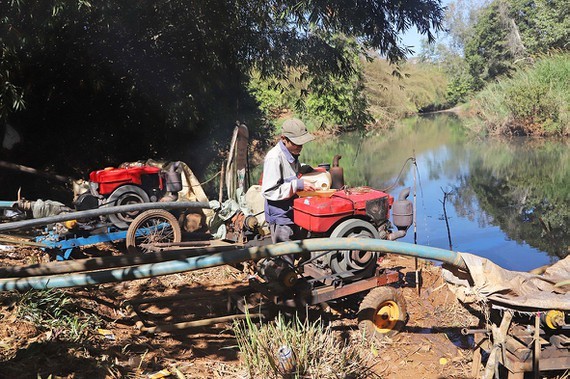
Although in the past days, there were rains in some places in Central Highlands provinces, the rainfall was low, mostly below 50 millimeters, so a shortage of water for coffee cultivation has not been solved yet.
According to Mr. Nguyen Hoai Duong, Director of the Department of Agriculture and Rural Development of Dak Lak Province, said that currently, there are around 8,949 hectares of crops being affected by drought in the province, of which 3,176 hectares are perennial plants. The remaining water reserves of small water reservoirs were merely below 35 percent of designed capacity, of which 64 water reservoirs have already been dry; medium and large water reservoirs had the remaining water reserves of around 40-60 percent of designed capacity. Some large water reservoirs had below 40 percent of capacity, such as the Upper Ea Sup water reservoir in Ea Sup District with 26 percent, Triet Village water reservoir in Lak District with 23 percent, and Hang Village water reservoir in Krong Pak District with 23 percent.
In Dak Nong Province, it is forecast that by mid-April, drought might occur on a large scale with around 17,068 hectares of crops in areas outside the scope of irrigation works suffering a shortage of water and drought. This situation also happened in many Southern areas of Lam Dong Province, of which, coffee tree accounted for a majority in the area of crops affected by drought.
To cope with a shortage of water for irrigation, farmers have had to drill water wells and dig ponds. In the areas where there is surface water, farmers use high-powered pumps to get water. Mr. Bach Xuan Mau, a farmer in Son Trung Hamlet in Dak Gan Commune in Dak Nong Province, spent more than VND50 million on pond digging and water well drilling but he still had no water to save his coffee trees. In the sustainable coffee area in Quang Tien Commune in Cu M’gar District in Dak Lak Province, the provincial Department of Agriculture and Rural Development has been rushing to build an underground pipeline system to supply water for coffee fields here.
Groundwater declined while surface water is also rapidly receding, therefore, if there is no additional water, drought will cause losses for coffee farmers. In the long run, impacts of water shortage will cause coffee trees to be weakened, giving low productivity.
According to Mr. Nguyen Hoai Duong, Director of the Department of Agriculture and Rural Development of Dak Lak Province, said that currently, there are around 8,949 hectares of crops being affected by drought in the province, of which 3,176 hectares are perennial plants. The remaining water reserves of small water reservoirs were merely below 35 percent of designed capacity, of which 64 water reservoirs have already been dry; medium and large water reservoirs had the remaining water reserves of around 40-60 percent of designed capacity. Some large water reservoirs had below 40 percent of capacity, such as the Upper Ea Sup water reservoir in Ea Sup District with 26 percent, Triet Village water reservoir in Lak District with 23 percent, and Hang Village water reservoir in Krong Pak District with 23 percent.
In Dak Nong Province, it is forecast that by mid-April, drought might occur on a large scale with around 17,068 hectares of crops in areas outside the scope of irrigation works suffering a shortage of water and drought. This situation also happened in many Southern areas of Lam Dong Province, of which, coffee tree accounted for a majority in the area of crops affected by drought.
To cope with a shortage of water for irrigation, farmers have had to drill water wells and dig ponds. In the areas where there is surface water, farmers use high-powered pumps to get water. Mr. Bach Xuan Mau, a farmer in Son Trung Hamlet in Dak Gan Commune in Dak Nong Province, spent more than VND50 million on pond digging and water well drilling but he still had no water to save his coffee trees. In the sustainable coffee area in Quang Tien Commune in Cu M’gar District in Dak Lak Province, the provincial Department of Agriculture and Rural Development has been rushing to build an underground pipeline system to supply water for coffee fields here.
Groundwater declined while surface water is also rapidly receding, therefore, if there is no additional water, drought will cause losses for coffee farmers. In the long run, impacts of water shortage will cause coffee trees to be weakened, giving low productivity.
























